Top News
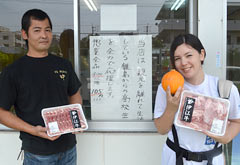
June 5, 2013 Ryukyu Shimpo
“We hope students from neighboring islands will eat well,” said Kenji Naka, 37, the manager of the Itoman direct sales shop of the Agricultural Production Cooperation Group Ie Gyu. This shop, which opened in April in Nishizaki, Itoman, offers support for high school students from neighboring islands by reducing the price of pre-cooked dishes and offering specialty Ie Beef for free. Naka who is also from a neighboring island, runs the shop with his wife Aiko. Despite making no profit from this initiative, they want to help the students grow up healthily.
Many students from neighboring islands without high schools leave home and start living on their own as they start high school. Some do not receive enough financial support from their parents to cover their needs, so they spend a lot of time working. Some students find it difficult to get accustomed to living alone and lose the balance on their lives. Supporting the academic and daily needs of high school students from neighboring islands has become a challenge.
Kenji devoted his high school life to club activities when he went to high school on Okinawa Island. He explains the reason for providing this support, “When some parents of high school age students from neighboring islands send their children away to high school they take out loans to pay for the running of two households. Some students who do not receive sufficient money to get by end up skimping on food costs. I want them to have a full meal without restraining themselves.”
Aiko hopes to expand the circle of support, “We also have a one year old child. So this situation may happen for us in future. If more people offer support, parents can send their children from neighboring islands without having to worry too much.
It has been one month since opening the shop. Since they put a poster up in the store advertising the service hungry high school students have come two or three times a week to receive their support.
(English translation by T&CT, Megumi Chibana and Mark Ealey)
Go to Japanese
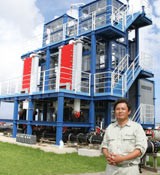
June 4, 2013 Ayako Sakaguchi of the Ryukyu Shimpo
The Okinawa Prefectural Government has been promoting a new energy policy. The Deep Sea Water Research Center on Kume-jima has been carrying out proof tests for Ocean Thermal Energy Conversion (OTEC) since April. This is a pioneer project for the new form of energy. Such proof tests for power generation plant in the water have not yet been carried out anywhere else in the world. The OPG has high hopes for renewable energy produced in Okinawa, which is suited to Ocean
Thermal Energy Conversion because of the temperature of its waters.
This power generation makes use of the energy that converts the temperature difference between the ocean’s warm surface and cold deep water into electric power. This can only happen if there is a temperature difference between the surface and deep water. Possible sites that have more than 20 degrees difference are Kume-jima, Ishigaki and Miyako.
According to the Ministry of Economy, Trade and Industry, Japan’s energy self-sufficiency rate, including natural energy and fossil fuels, was about 4 percent in fiscal 2010. “Fossil fuels will run out soon, so from now we should try to increase the figure of 4 percent,” said Shin Okamura, a section chief at Xenesys Inc., which is responsible for managing the OTEC. Producing high-quality energy by attracting Japanese technology will help to create new jobs and industries.
“Ocean Thermal Energy Conversion can generate more stable electricity than wind or solar sources due to its constant temperature. The power generation plant on Kume-jima will become our showroom to the world,” said Yasuyuki Ikegami, a researcher at Saga University, who has studied the ocean for more 30 years.
The plant is now successfully generating 10 of its maximum output of 50 kilowatts. It will connect its transmission lines with those of the Okinawa Electric Power Company from June and will be able to use private power generation in the facility.
On June 16, the Okinawa Prefectural Government will hold a power distribution ceremony for the demonstration plant.
(English translation by T&CT, Mark Ealey)
Go to Japanese
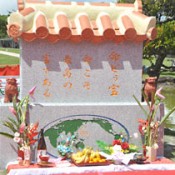
June 10, 2013 Ryukyu Shimpo
On June 9, in front of the Cornerstone of Peace at the Okinawa Prefectural Peace Memorial Park in Mabuni, Itoman, an unveiling ceremony was held of a stone monument for world peace. The words “Nuchi du Takara (Life itself is our treasure)” are inscribed on the monument.
About 30 people involved in erecting the monument celebrated its completion.
In the four languages of Japanese, English, Korean and Chinese the creators inscribed the words: “War is over. Peace is what our hearts create. Our most precious treasure is life.” They asserted, “We will tell the preciousness of peace and our anti-war stance from Okinawa to the world.”
Akihiko Kato, the chief organizer of the ceremony said, “The monument is only small but I believe that the message delivered by the Okinawan people will cross national boundaries in a timeless way to spread among the people of the world.”
Itoman Mayor Hirotsune Uehara said, “Itoman was the scene of some of the bloodiest fighting in final stages of the Battle of Okinawa. It is good that this monument for world peace has been built. We would like to use it for peace education for children.”
(English translation by T&CT, Mark Ealey)
Go to Japanese
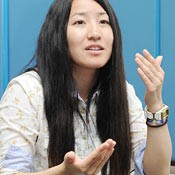
June 5, 2013 Ryukyu Shimpo
From July 26 in Sofia, Bulgaria, the International Olympic Committee will hold the Summer Deaflympics, in which deaf athletes compete at an elite level. Miki Takara, from Tomigusuku and a senior at Shikoku Gakuin University, will represent Japan in volleyball.
This is the first time for a female athlete from Okinawa to participate in this sport.
The Japanese team won the final of the Asian Games, which were held as a preliminary round for the Deaflympics. Takara is a setter in the team. On June 4, she visited the Ryukyu Shimpo to give an interview. Using sign language Takara said, “I’ll go out on the court feeling grateful to all those people who have supported me, and I want to bring back a gold medal.”
Takara is the shortest in her team at 152 centimeters, but she can toss the ball up well in attack and is quick and precise in her movements. She is one of the team’s key players. Her team took part in the world championships held in Bulgaria last August and was placed fifth.
Takara was born hearing impaired. She started playing volleyball when she was in the first grade at Tomigusuku Junior High School. “My seniors forced me to join the club,” said Takara with a smile. After she started to play the sport she came to like it.
Most of her teammates had played since elementary school and the practices were tough. However, her teammates helped her with one-to-one extra practices after the team meetings. “I appreciate all the help I had from my friends. Volleyball has taught me about some of the key physical and mental aspects of life.”
After entering the Okinawa Prefectural School for Hearing-Impaired Children, Takara joined the Okinawa Prefectural Hearing-Impaired Person Association Women’s Volleyball Club. She then went on to Shikoku Gakuin University in Kagawa Prefecture. Twice a month Takara has a three-hour bus ride to meet up with the team in Hyogo Prefecture. She wants to further improve her skills by working out in the gym every day.
Takara said, “I play volleyball out of gratitude to those who have supported me along the way.”
She said, “I will try to catch every ball and toss the ball up well for us on attack. I am looking forward to the Deaflympics.”
About 2,500 people from 77 countries took part in the 2009 Summer Deaflympics.
(English translation by T&CT, Mark Ealey)
Go to Japanese
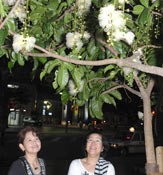
June 6, 2013 Ryukyu Shimpo
Sagaribana powderpuff trees are blooming along the avenue by the Palette Kumoji shopping mall in Kumoji, Naha, creating an even more attractive night downtown. Adorable pink or white flowers with a subtle fragrance delight passers-by.
Sagaribana are mainly found in the area ranging from Nansei Islands, including Okinawa, through to Southeast Asia. Their filiform flowers open in the evening and fall at dawn. Machiko Konesu and Noriko Miyahira, who saw the flowers for the first time in the evening of June 5, thought that they were mysterious and had a pleasant fragrance.
(English translation by T&CT, Mark Ealey)
Go to Japanese

Go To Video

June 2, 2013 Shuko Oshiro of Ryukyu Shimpo
On 26 May, the final day of the Summer Grand Sumo Tournament held in Tokyo, wrestler Chiyoo narrowly posted a losing record with seven wins and eight losses. Chiyoo, whose real name is Miyohito Motoi, has become the first juryo level (second of six divisions) sumo wrestler with a connection to Okinawa in 11 years.
He graduated from Chubu Agricultural High School in Uruma and belongs to Kokonoe Stable. Boarding house owner Koji Yamamoto and his wife Mutsuyo, whom the sumo wrestler refers to as his “parents in Okinawa,” said, “This narrow losing record will lead to better results in the next tournament.” The Yamamotos looked after Motoi when he came from Yoron Island as a boy to train at the high school.
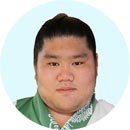
Chiyoo
They took Motoi in to their house for two years because their 21-year-old son Kota, who is now at Nihon University, was one year below Motoi in the sumo club at high school. “He’s such a genuine and generous young person, the sort who really has special feelings towards his mother,” said Mutsuyo. She smiled fondly as she recalled serving him his favorite meal of macaroni salad with ice cream as dessert.
When he became captain of the sumo club in his second year they told him to stay focused on his mission and often gave him stern words of advice. He was a wrestler who picked up many injuries along the way. Koji remembers telling the young man, “Things won’t always go smoothly for you. Try to stay positive during the hard times too.”
By the time Motoi finished high school he had effectively become a member of the Yamamoto family. They recall how at his farewell party their son Kota tearfully said, “Miyohito is my big brother for life.” Chiyoo has established a name for himself in the sumo world quickly. Despite only starting at high school he has been promoted to juryo in just three years since his debut. “He has done well in the tough world of sumo,” said Koji. In the Summer Tournament, after two defeats from the first day he won four bouts in a row but then lost the next four bouts in a row, finishing with a record of seven wins and eight losses. “To be promoted to the higher levels in sumo a wrestler needs to be good mentally, technically and physically. On top of that he needs a luck. Chiyoo is just 22 years old. We want him to keep working hard and to become a wrestler who helps to cheer everyone up.”
(English translation by T&CT, Mark Ealey)
Go to Japanese

June 3, 2013 Sadao Tome Correspondent of Ryukyu Shimpo
Seventy-nine-year-old Eijiro Gibo, a recognized authority on Okinawan traditional arts and former head of the Okinawa Prefectural Museum, and 94-year-old Seiyu (subsequently: Frank) Agarie have met for the first time in 68 years.
Gibo played a part in organizing the meeting between Agarie and his brother in 1945 when they fought on opposite sides during the Battle of Okinawa.
Gibo and Agarie were reunited in Las Vegas, and two months later Gibo wrote a letter to Agarie about Okinawa 68 years ago and soon after the war.
Sixty-seven years ago, someone dressed in a U.S. military uniform riding on a jeep came along when 12-year-old Gibo and his friends were trying to capture a wild pig in Yabe, Nago. The man, who seemed to be a second-generation Okinawan-American, spoke to them in the Nago dialect, saying, “Do you know any Nago people around here?”
Put at ease hearing the Nago dialect, Gibo used his connections to find Agarie’s brother Yasuharu in the hills of the Nago area.
In the letter, Gibo wrote that “Local citizens beat up U.S. soldiers because they often assaulted local women.”
Gibo told Agarie that Okinawa still faces the same problems as 68 years ago.
In recognition of Gibo’s achievements in areas such as folk art and critical writing, the Japan Folk Song Association gave him an award in 2006. He has written books about eisa and kumiodori, and has served as the head of the Okinawa Prefectural Council for Cultural Affairs and as a professor at Okinawa University.
Christian minister Toshio Maehara and Okinawan civilian ambassador in Los Angeles Tamiko Uehara managed to link up Gibo and Agarie again.
(English translation by T&CT, Mark Ealey)
Go to Japanese
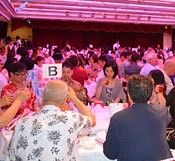
June 2, 2013 Ryukyu Shimpo
On June 1, at Jubilance in Ginowan, the AmerAsian School in Okinawa celebrated the 15th anniversary of its establishment. Amerasian refers to people born in Asia to a U.S. military father and an Asian mother.
About 200 people – current students, parents, former students and well-wishers – attended the party.
Although only 39 students have officially graduated from the school in the past 15 years, about 400 have been enrolled at the school during that period. Some of the graduates went on to high schools or colleges and found work in Japan or the United States.

School principal, Midori Thayer.
Children who studied in the school have steadily begun to leave the nest and go on to become members of society.
The school principal, Midori Thayer, who is the mother of Amerasian children, was among those who founded the school in 1998.
Starting off as an unlicensed free school, it accepts Amerasian children who do not fit into Japanese schools because of the language barrier. The school teaches them in both Japanese and English.
Looking back on the time when the school was founded, Thayer said, “We didn’t have anything except passion and dreams. It was the start of a tough path forward.”
Despite criticism, the Okinawa Civil Rights Association and Okinawa Bar Association supported Thayer and the other people involved in the school.
The municipal governments of Ginowan and Okinawa certified the school in 1999 and Urasoe did the same in 2000. They decided to recognize attendance at the school as equivalent to that at public schools.
Thayer said, “Many Amerasian children struggle with a sense of alienation both in Japan and the United States. I want to create a place for them.” For the last 15 years, Thayer has committed herself to promoting a learning environment for Amerasian children.
She said, “Workplaces such as customer service desks at public institutions and hotels want bilingual people. I want our school’s students to work for Okinawa and to be able to foot it internationally.”
Eighteen-year-old Janey Sachi Fukunaga, who graduated from the school and is now a first-year student at Okinawa International University, said, “In the school, the students with the same family circumstances study together every day like family members. I enjoyed my school life with that family-like atmosphere.”
Now studying bookkeeping, Fukunaga said, “I want to become an international tax accountant.”
(English translation by T&CT, Mark Ealey)
Go to Japanese

May 31, 2013 Ryukyu Shimpo
On June 22, the “Clean-Pic” national convention will be held at the Yonashiro Comprehensive Park in Uruma. Clean-Pic is a new activity designed to help clean up beaches, and is something that people can participate in casually. On May 30, the Planning Committee announced that they would hold the convention in Urasoe and are now calling for teams to take part in the event.
Koji Kinjo, head of the Planning Committee and involved in the transplanting of coral, came up with the idea for this activity. The aim is to use competition to get people to pick up even more trash, and at the same time, to raise awareness about environmental issues.
The competition is divided into the two sections of beach and sea. Teams compete against each other with the score depending on the type of trash.
The deadline for application is June 22. The participation fee is 5,000 yen per team and the first prize is 200,000 yen.
Kinjo commented, “It is becoming difficult to continue cleaning up beaches by just relying on volunteers. By making it into a sport competition we have attracted more people and have much less trash on the beach.”
Call 098 (982) 9988 to contact the Planning Committee.
(English translation by T&CT, Hitomi Shinzato and Mark Ealey)
Go to Japanese
May 31, 2013 Ryukyu Shimpo
The central government has submitted corrected documents of the application to the Governor of Okinawa for permission to reclaim land off Henoko, Nago to start the relocation of U.S. Marine Corps Air Station Futenma. At 11:53 a.m. on May 31, officials of the Okinawa Defense Bureau delivered the documents to a local office of the Okinawa Prefectural Government (OPG).
Later that same day Okinawa Governor Hirokazu Nakaima said, “We need to look through the documents first. Now we can get to work on checking the application. Following the rules, we will now consider whether or not to accept the application.”
A representative of the OPG said, “If we confirm that the ministry has adequately corrected the application documents, we will get them ready for public inspection.
If they have not adequately corrected them, we ask the government to do it again.”
Director of the Okinawa Defense Bureau Hiroshi Takeda said, “Removing the dangers posed by Futenma Air Station is a pressing issue. We will not allow Futenma to become a permanent fixture. Some people criticize the land reclamation project, but we will continue to explain government policy and do our best to gain the consent of the Okinawan people.”
On April 12, the OPG asked the Okinawa Defense Bureau to correct the written application the central government submitted to the Governor of Okinawa on March 22. The OPG asked the central government to file the corrections by June 11.
(English translation by T&CT, Mark Ealey)
Go to Japanese
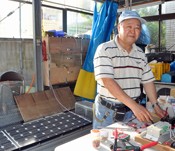
June 1, 2013 Ryukyu Shimpo
Former high school teacher Masaru Majikina, a 63-year-old resident of Urasoe, is making a solar power system for homes of Yonaguni residents. Every year locals are inconvenienced when typhoons cause power outages. Majikina, who is also a natural energy researcher, is speeding up the pace of his work to finish before the typhoon season. He will visit Yonaguni in late June to install the equipment.
Majikina began to study natural energy by himself about 40 years ago when was teaching at a technical high school. The first area he researched was wind power. “I came to understand the importance of energy at the time of the oil shock,” he said.
He began to study solar power five years later when he was working at Chubu Technical High School (now Mirai Technical High School). After that, he tackled making use of a hybrid system combining two types of natural energy. Now, separate to the power supplied by the Okinawa Electric Power Co., in his own home he has in-house power generation using natural energy.
After hearing about him through the media, this April a resident of Yonaguni asked Majikina to make a solar power unit for his house. The Majikina family can use home-generated solar electricity during power outages. The solar panels are made by a Japanese manufacturer and are compact in size, high-performance and resistant to salt damage. Through a trial and error process, he added an air-cooling function to avoid the panels over-heating and reduced air resistance to withstand the typhoons on Yonaguni. “I hope it helps people there to lead their lives without having to use flashlights or candles,” Majikina said.
(English translation by T&CT, Mark Ealey)
Go to Japanese













 Webcam(Kokusai Street)
Webcam(Kokusai Street)


